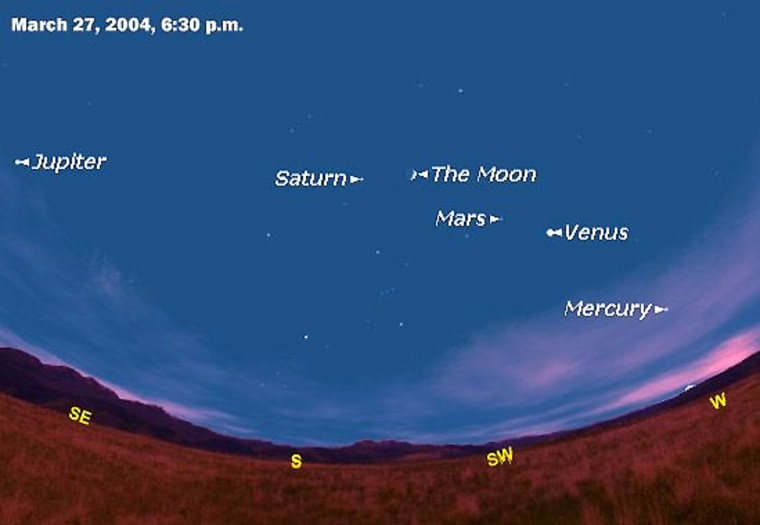Skywatchers are presently enjoying the spectacle of simultaneously having the five brightest planets visible in the early evening sky, an parade of worlds enjoyable without the help of telescopes.
As I noted in a column earlier this month, the most elusive of these is Mercury. It has been in the evening sky only since mid-March, and it will vanish in about another ten days.
But right now, the fleeting world is at its best, and the lineup of easy-to-spot planets won't be as favorable in the evening sky again until 2036.
Mercury is called an "inferior planet" because its orbit is nearer to the Sun than the Earth’s. Therefore, it always appears from our vantagepoint to be in the same general direction as the Sun. And so relatively few people have actually set eyes on Mercury. There is even a rumor that the famed astronomer Copernicus (1473-1543), living in northern Poland, never saw it.
Yet the small planet is not really hard to spot. You simply must know when and where to look, and you need a clear view western horizon.
How to find it
People in the Northern Hemisphere are currently in the midst of a fine window of opportunity for viewing Mercury in the evening sky. That window, which will close after April 5, will continue to provide good chances to see this and four other fairly easy-to-find planets with the naked eye.
Currently, Mercury is visible about 45 minutes after sunset, very near to the horizon, a bit to the north of due west. Yet, if your sky is clear and there are no tall obstructions to your view (like trees or buildings) you should have no trouble in seeing it as a very bright "star" shining with just a trace of a yellowish-orange tinge.
Among the stars and planets, Mercury now ranks a very respectable fifth in brightness, behind Venus, Jupiter, Sirius (the brightest star) and Canopus. Mercury is shining at a very bright magnitude of minus 0.4, on an astronomer's scale in which smaller numbers represent brighter objects, and negative numbers are reserved for the brightest of all.
In the evenings that follow, Mercury will diminish – slowly at first -- in brightness, but it will also be arriving at its greatest elongation, 19-degrees to the east of the Sun, on Monday, March 29. That means it is as high in our sky as it will get during this apparition.
(Imagine looking down on the solar system from above. Picture the Sun at the top of a diagram, and Earth at the bottom. Mercury will be directly left of the Sun. From this view, all of the five visible planets are to the left of the Sun right now.)
And, by an amazing coincidence, Mercury will arrive at its greatest eastern elongation on the very same day as does brilliant Venus, which will blaze at magnitude minus 4.4.
Shining at magnitude 0.0 (just a trifle brighter than the star Capella, in Auriga), Mercury will appear well below and to the right of Venus and setting more than 1½ hours after the Sun. As a result, this will be Mercury’s best evening apparition of 2004.
Phases of Mercury
Mercury, like Venus and our Moon, appears to go through phases.
During mid-March, just when Mercury started appearing in western twilight, it was a nearly full disk, which is why it started out appearing as bright as Sirius. By the time it arrives at its greatest elongation on March 29, it will appear roughly half-illuminated and the amount of its surface lit by the Sun will continue to decrease in the days to come.
So when it begins to turn back toward the Sun’s vicinity after March 29, it will fade at a rather rapid pace, waning in apparent size from our point of view.
In fact, on the evening of April 5, Mercury’s brightness will have dropped to magnitude +1.6; only as bright as the star Castor in Gemini and just one-sixth as bright as it is now. In telescopes it will appear as a narrowing crescent phase. This day in all likelihood will be your last chance to view it, for the combination of its rapid fading and its descent into the brighter sunset glow will finally render Mercury invisible by the second week of April.
Swift of foot
In old Roman legends, Mercury was the swift-footed messenger of the gods. The planet is well named, for it is the closest planet to the Sun and the swiftest of the Sun’s family, averaging about 30 miles per second and making its yearly journey in only 88 Earth-days.
Interestingly, the time it takes Mercury to rotate once on its axis is 59 days, so that all parts of its surface experiences periods of intense heat and extreme cold. Its mean distance from the Sun is only 36 million miles (58 million kilometers), but Mercury is not just hot. It experiences by far the greatest range of temperatures of any planet in the solar system, from nearly 900 degrees Fahrenheit (482ºC) on its day side to minus 300 degrees Fahrenheit (-184ºC) on its night side.
In the pre-Christian era, this planet actually had two names, as it was not realized it could alternately appear on one side of the Sun and then the other. Mercury was called Mercury when in the evening sky, but was known as Apollo when it appeared in the morning.
It is said that Pythagoras, about the 5th Century B.C., pointed out that they were one and the same.
